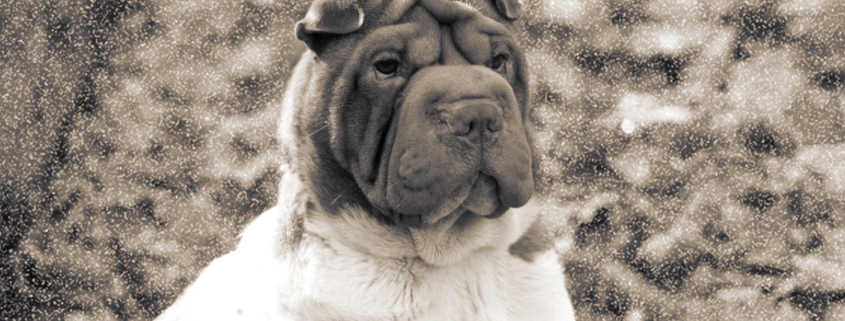BY CHERESE COBB, FREELANCER
Pepper was black, short and chunky. The one-year-old Shar-Pei looked like a baby hippo. She had mange and infected ears. Chained outside in the heat, she stunk badly. Her owners wanted to euthanize her. But there was something special about her. Kathy Baily, the president of Shar-Pei Savers in Genoa, Ohio, adopted Pepper and trained her to be a therapy dog. (Next year, she’ll be 12 years old.) Independent, regal, alert and dignified: Is this wrinkly wonder right for you?
History
The Shar-Pei most likely originated in the small fishing village of Tai Li in southeastern China during the Han Dynasty (206 BCE-220 CE). While Marco Polo’s journal, published in 1271, only mentions Pugs and Chow Chows, a translation of a 13th-century Chinese manuscript refers to a dog with a “sandpaper-like coat” and a blue-black tongue.
Chinese farmers used Shar-Peis for hunting, herding and guarding their livestock. Following the establishment of the People’s Republic of China as a communist nation, Shar-Peis were declared upper-class luxuries and were virtually wiped out. During this period, a handful was smuggled into Hong Kong and Taiwan.They were crossbred with Tibetan Mastiffs, Chow Chows, Great Pyrenees, Bulldogs and Boxers.
In April 1973, Matgo Law, owner of Down-Homes Kennel in Hong Kong, begged U.S. dog fanciers to “save the Shar-Pei.” Then the “Guinness Book of World Records” proclaimed the Chinese Fighting Dog the rarest dog breed on Earth. Commercially-minded breeders pumped out litters as quickly as impulsive buyers could pull out their credit cards. By the mid-’80s, the Shar-Pei craze died down.
Clowning Around
On April 1, 2018, Jineen McLemore-Torres adopted Jameson from Shar-Pei Savers. At three months old, he hadn’t opened his eyes. “He had a visible cherry eye, and we believe the breeder who surrendered him was unable to sell him,” she says.
“Jameson was initially a medical foster, but my female Shar Pei Jade and I both fell in love with him,” Jineen says. When he’s not lounging on his favorite bed or digging in the mud, he’s running full speed into the couch, without even trying to jump up on it. “When I was playing with him last…he threw himself on the ground, making a loud thump, rolled on to his back, legs in the air and expected a belly rub while nibbling on my hands.”
His stubbornness always rears its ugly head whenever he’s at the store or an event. If he doesn’t want to leave, he plops down on his side or back and refuses to move. “Everyone thinks it’s hilarious, but it doesn’t feel funny when it’s happening to me,” she admits.
Whenever you try to teach a Shar-Pei a new trick without his favorite treats (ahem…antlers), he’ll throw shade at you. While Jameson is a bit lazy, he earned his AKC Star Puppy certification when he was under a year old. Jineen recently began teaching him to shake hands and give high five. “I thought it’d be at least a week of short sessions,” she says, “but at the end of a 10-minute session, he was throwing his paw up.”
Health
“The joke in the Shar-Pei world is, if you’re not willing to spend thousands on your dog for healthcare, don’t get a Shar-Pei,” Kathy says. Shar-Peis are prone to familial Shar-Pei fever (FSF), which causes fever, temporary joint pain and swelling. It can lead to polyarthritis, liver failure and kidney failure.
“There’s no cure for FSF; only supportive care,” says Dr. Erin Wilson from Spring Harbor Animal Hospital in Madison, Wis. “Owners should talk to their family vet about keeping pain medications or non-steroidal anti-inflammatories on hand for painful flare-ups. They should also learn how to take their Shar-Peis’ temperatures, as prolonged elevated body temperature may require hospitalization and IV fluids.”
Shar-Peis are also susceptible to skin infections, eye problems (like retinal dysplasia or glaucoma) and bloat, which is a potentially fatal twisting of the stomach that requires immediate surgical treatment. “We’ve also found that dogs with a horse coat will tend to get kind of a smell to them,” Baily says. “They sleep in a ball, so their bellies tend to get stinky.” Use a baby wipe or gentle shampoo.
While Shar-Peis don’t require a lot of exercise, a sweater or jacket may be needed during the worst of the winter months. “During summertime, walking should be limited to early mornings or evenings when the weather is cooler,” Dr. Wilson says.
Should You Adopt a Shar-Pei?
Shar-Peis don’t show well in shelter settings. When people walk by their cages, they either shrink back or start to bark. “People see that side of them and think, ‘I don’t want a dog like that,’” Kathy says. But Shar-Peis are extremely intelligent and devoted to their families. They slowly warm up to strangers but generally are great once you get to know them. “They are very clean dogs and housetrain very young…and they give the best hippo kisses.”


